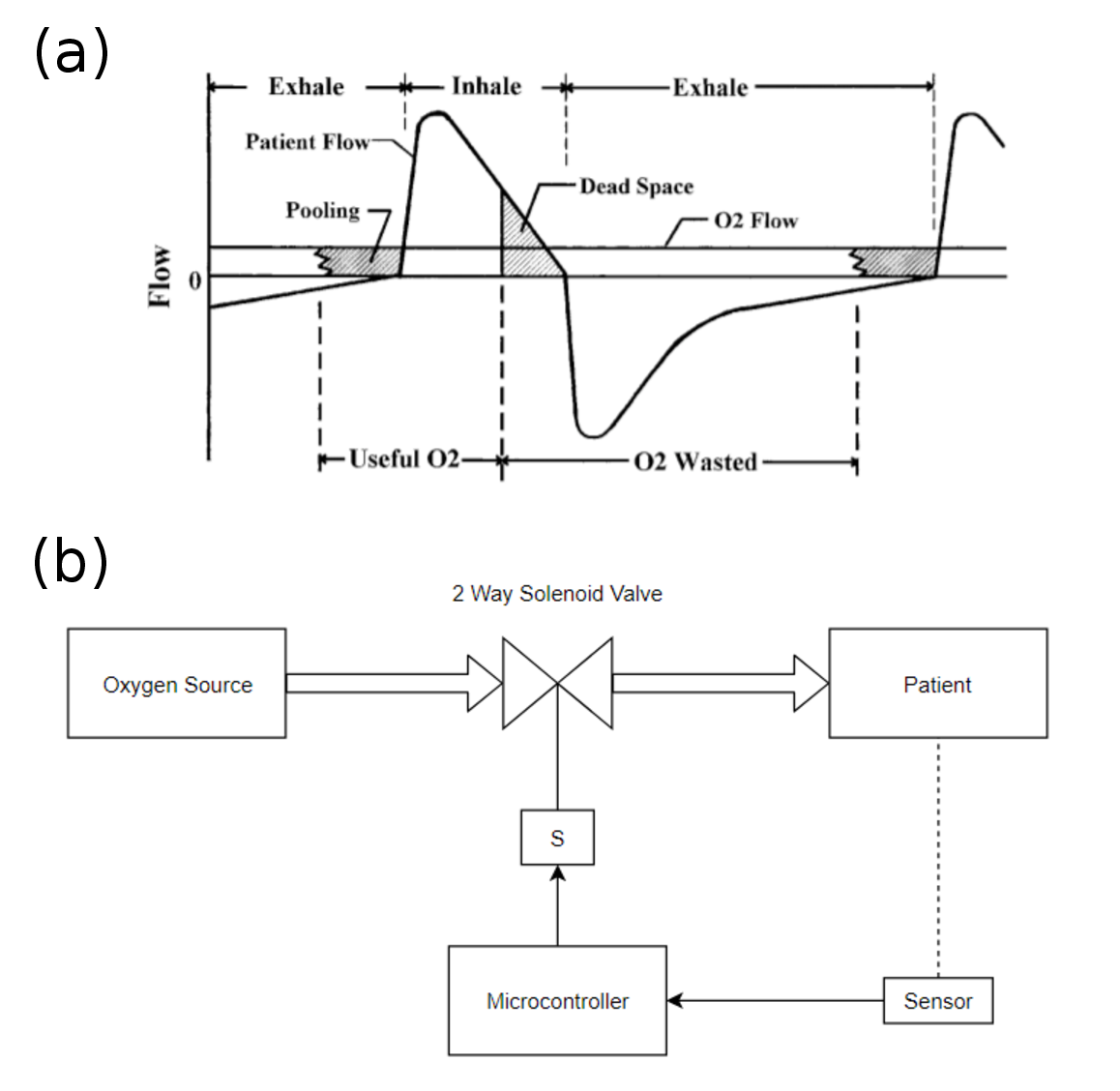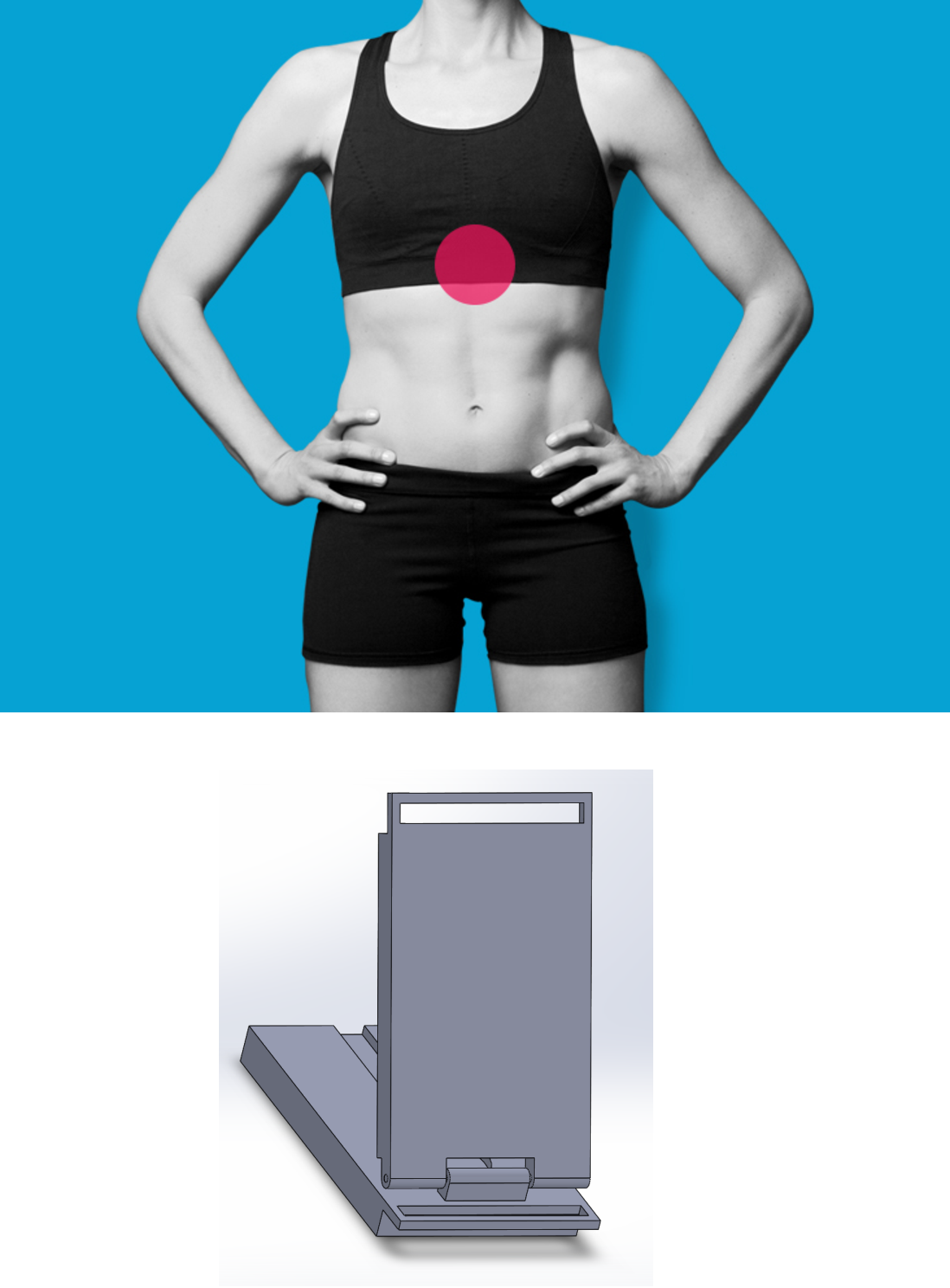
Background
The 2nd wave of the COVID-19 virus has exposed a host of supply chain and production issues pertaining to medical oxygen. It is found that a fraction of oxygen during inhalation is actually inspired and the rest of the oxygen simply rejected into the atmosphere. In view of this, we have designed and tested an oxygen conservation device. The purpose of the document is to enable manufacturers and suppliers to develop an ecosystem for component supply and/or development of the entire product.
Process

The device cuts off supply during exhalation but keeps the supply on during Inhalation and Pooling. A solenoid valve is connected in between the oxygen source (concentrator or cylinder) and the patient. The valve provides only digital control (either ON or OFF) and does not control the rate of flow oxygen. The solenoid valve is controlled by a microcontroller (Arduino). The microcontroller uses a Force Sensing Resistor like the FSR402 or FlexiForce A401 is used to capture the phase in which the breathing cycle is in. Accordingly the microprocessor switches the solenoid valve ON or OFF to stop or resume the flow of oxygen to the patient.
There are three states of the system, Pooling, Inhalation, Exhalation. Two states are identified, inhalation and exhalation. Pooling state is expected to begin at a fixed time before inhalation begins. This time-parameter can be tuned via code uploaded.
Quick setup
If this LED misbehaves, check if the toggle switch is in the middle position or not. If not, just toggle between the required Mode position and middle position.

Construction
Pneumatics In order to maximize reliability, high quality pneumatics are desired, such as those manufactured by Festo. All the threaded connections are 1/4” BSP while all the push-fit connectors are for an 8mm OD tube. For convenience, we mention that the drill and tap size for the 1/4” BSP threads is 7/16” drill and G1/4” tap.
Sensors A force sensing resistor is encased in a sensor casing.
Slots are available in the casing to tie the casing to the belt. The belt should be tight enough to induce compression on the sensor but better sensitivity is achieved if the belt is as loose as possible.
The design was made according to dimensions of FSR406 but the size may be changed as required. Other sensors commonly available in market include FSR402 [2] and FlexiForce A401 may also be used. The resistances provided these are similar (100K 10K) and should be compatible.
Processing: Arduino code for the Oxy-saver device
Bill of materials
Acknowledgments
The work at IIT Kharagpur has been undertaken by Sridhar Singhal (Dual Degree Student, Department of Electronics and Electrical Communication Engineering), Prof. Aditya Bandopadhyay (Mechanical Engineering Department), and Prof. Manoj Mondal (Rajendra Mishra School of Entrepreneurship). This work has been made possible through the generous and timely funding received from the IIT Foundation in USA in memory of AK Singh (Batch of 1993), and from Mrs. K. V. S. Jagdamba, wife of Prof. Mondal.
Refined PCB design and assembly by Robot Jam India Pvt. Ltd.
Disclaimer
Disclaimer of Medical Liability. WE, THE UNDERTAKERS OF THIS WORK ON OxyConserver Oxygen Conserving Device DESIGN AND MANUFACTURE, DO NOT PROVIDE MEDICAL ADVICE. The contents of the Site are for general informational purposes only. The content is not intended to be a substitute for professional medical advice, diagnosis, or treatment. Reliance on any information provided on the Sites is solely at your own risk. Individual medical needs are very different; you should not assume that the information on the Sites concerning certain courses of treatment or outcomes will apply to you. Rather, you should evaluate your medical condition and make treatment decisions based upon consultation with your physician.
The contents of the Sites may be of interest to medical professions or other health care providers. Medical professionals and health care providers should exercise their own judgment in determining whether a particular product or procedure is appropriate for their practice or their patients.
IIT Kharagpur and the makers of the OxyConserver Oxygen Conserving Device make no warranties, expressed or implied, including, but not limited to, any implied warranty of fitness of KGP-O2 oxygen concentrator except for usage for COVID 19 purposes and in accordance with the prescribed standards.
IIT Kharagpur and the makers of the OxyConserver Oxygen Conserving Device shall not be held responsible for for any inappropriate use and/ or misuse of the OxyConserver Oxygen Conserving Device by the user and any resultant effect/ impact/ injury.
References and Resources
[1] : https://c.aarc.org/marketplace/reference_articles/01.00.0095.pdf Oxygen-Conserving Techniques and Devices - Robert McCoy
[2] : https://www.trossenrobotics.com/productdocs/2010-10-26-DataSheet-FSR402-Layout2.pdf FSR402 Sensor Datasheet
[3] : https://www.dropbox.com/sh/l9vke1e2y8kvcgx/AADlQ-4gCFAzl0BPA0Cfjfiia?dl=0 - PCB File
[4] : https://www.dropbox.com/sh/f23xz7vmfuxrdae/AADDFMEtvmck43ycXjM376Pya?dl=0- Sensor Casing CAD files
[5] : https://github.com/sridhar-singhal/oxy_saver GitHub Repository